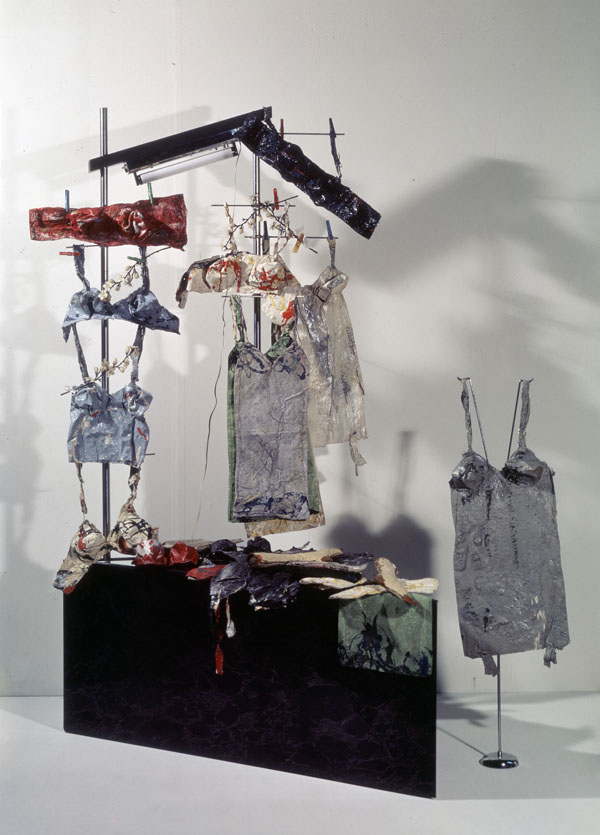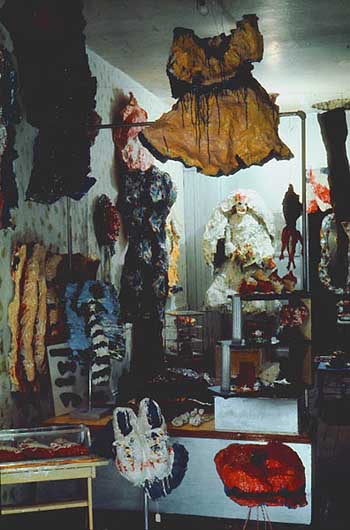INSTALLATION STUDY: CLAES OLDENBURG'S CONSUMER GOODS
In elementary school I had the same art teacher from Kindergarden through the 5th grade. One year, she taught us about pop art. She told us to think of ordinary objects that we could make out of clay, so I made a glass 7 up bottle with a crack in it. (I decided since pop art was a movement from the 60s, I should do a vintage ordinary object. Plus my dad had a cool 7 up wooden crate and I wanted him to like my work, so it seemed linear at the time). The broken bottle was my favorite sculpture I ever made, but I was as terrible at glazing then as I am now, so it came out 'statue of liberty green,' leaving me slightly disappointed. This was one of my first lessons in how difficult it is to get something you see so vividly out of your head correctly.
Looking back at pop art is not always easy for me because a lot of what popularized it is really terrible in my opinion. And some of what pop artists did later in their careers (during the 90s especially) is unforgivable. But, growing up in Southern California, I've always had a thing for fake food displays, which were found at fast food restaurants like Foster's Freeze's. These little displays always seemed like accidental pop art to me.
In the vein of Foster's fake food displays, while poking around on pinterest recently, a friend of mine (Dorothy Hoover) posted a picture of Claes Oldenburg's The Store. I had never heard of Claes Oldenburg, but his work caught my eye, so naturally, I began researching.
The Store, 1961-1962
First Claes Oldenburg work to catch my eye
Claes Oldenburg was born on January 28, 1929 in Stockholm. Son of a Swedish diplomat, Oldenburg spent his early years in New York until 1936, when his family moved to Chicago. In early adulthood, Oldenburg studied literature and art history at Yale between 1946 to 1950, and continued his education back home at the Art Institute of Chicago.
In 1956, Oldenburg moved to New York where he worked in the library of the Cooper Union Museum for the Arts of Decoration. After three years of working in this enviroment, Oldenburg started to make figures, signs and sculptural objects out of papier-mâché, and everyday materials. This work led to his first exhibition, The Street in 1960-1.
The Street exhibited at the Judson Gallery (at the Judson Memorial Church, my favorite location for art in NY during the 60s and 70s). The exhibition showcased ordinary objects and everyday consumer goods made from cardboard, burlap, and newspaper that recreated scenes from street life in New York City.
Abstract Expressionists are credited for having introduced ordinary objects in their artwork beginning in the 1940s, but it wasn't until pop art hit New York that these ordinary objects were not only depicted, but they were also used as medium. During this time, Oldenburg fueled a movement that influenced other artists through the 1970s, opening up a variety of media as fair game.
The Store - First Gallery Exhibition at Green Gallery
In 1962, Oldenburg created my favorite exhibition, The Store, which was a comedic display of a somewhat distopic throwback to New York's Five and Dime stores where everything from mops and men's shirts, to canned foods and seasonal decor could be purchased. In a rented store front in the East Village, Oldenburg again used materials from everyday objects.
Years after the exhibition, a compilation of Oldenberg's writings were published as Writing on the Side, including a 1961 diary entry where he discusses his concept behind The Store:
The Store, or My Store, or the Ray Gun Mfg. Co., located at 107 East 2nd St., NYC, is eighty feet long and is about ten feet wide. In the front half, it is my intention to create the environment of a store by painting and placing (hanging, projecting, lying) objects after the spirit and in the form of popular objects of merchandise, such as may be seen in store windows of the city, especially in the area where The Store is (Clinton St., for example, Delancey St., 14th St.).
This store will be constantly supplied with new objects, which I will create out of plaster and other materials in the rear half of the place. The objects will be for sale in The Store.”
From the entries published in Writing on the Side, we learn that leading up to his creating The Store, he meticulously catalogued every sandwich, can of beer, box of cigarettes and brand of soap he purchased, as well as every cafe and restaurant he visited as a reference for his body of work.
From here, Oldenberg continued to create and work with ordinary objects, making an ongoing series known as Soft Sculptures. These are some of the funniest pieces in my opinion, because with the help of his first wife, he sewed oversized everyday objects such as cake (which he hilariously calls Floor Cake), toilets, and household appliances. Considering the early 60’s was still feeling the affects of the 1950’s futuristic, perfect, automated, domestic ideologies, Oldenberg's almost grotesque, and very hand-made portrayal of these objects was a jab at the American Status Quo, and perhaps at the same time, an homage to what seemed like a dwindling way of American Life.
Around the same time that Oldenberg started making sculptures, he also participated in performance art at the Judson & then later at The Store. These performances made by pop artists were known as Happenings, and Oldenberg's particular theatre was called Ray Gun Theatre. The main idea behind pop art was to take art out of the 'white walled gallery' and 'off its pedestal;' an idea that had not yet become palatable to the everyday art lover. By turning the audience into "just another object" the performances were meant to express the frustrations artists had with the status of the art world at the time.
From the attention received between The Street, The Store, and Soft Sculptures, as well as his time working at the Judson, Oldenberg is now credited with helping create the Pop Art movement, which began in New York. But shortly after his first exhibitions, Oldenberg moved to Los Angeles in 1963, "because it was the most opposite thing to New York [he] could think of." (Funny because I left LA for NY for the exact same reason).
Once in LA, Oldenburg created a performance called AUT OBO DYS, a quintessentially Los Angeles performance done in a parking lot. After this work, Oldenburg shifted his focus to sketching and idealizing large-scale sculptural monuments in public spaces. In 1967 his first sculpture was afforded by New York city cultural adviser Sam Green. This was Oldenburg's first outdoor public monument known as Placid Civic Monument, which was a performance made behind the Metropolitan Museum of Art with a crew of gravediggers digging a 6'x 3' rectangular hole in the ground.
Oldenburg was met first with criticism and opposition, because his works he wanted to create were gigantic public sculptures of ordinary objects. But today, most of Oldenburg's recognizable work comes from this period and is displayed in public spaces throughout the United States.
To be honest, I appreciate his progression, but I LOOOOVE the 60’s work and just don't appreciate his later work as much. For this reason, I'm not posting any pictures here but you can find them very easily on the internet.
However, fast forward more than 50 years and Oldenburg's Store is showing up as a major influencer for in recent exhibitions, including a fake Bodega in NY's meatpacking district and at the Volta Fair in NY where clay/plaster mops, bottles of Tide detergent and an overturned studio stool covered in chewing gum directly recreate objects using Oldenburg's concepts behind The Store.
Courtney Bagtazo, © Bagtazo 2017
BIBLIOGRAPHY
Claes Oldenburg: The Street and The Store Claes Oldenburg: Mouse Museum/Ray Gun Wing, THE MUSEUM OF MODERN ART, 2013
Revisiting 'The Store' by Claes Oldenberg. Makiko Wholey, Inside/Out (Moma PS/1), JUNE 26, 2013
The Sanitizing of a Junk-Art Genius. Jed Perl, New Republic, August 25, 2013
When Bigger Is Better: Claes Oldenburg has spent the past 35 years blowing up and redefining everyday objects, all in the name of getting art off its pedestal. Kristine McKenna, Los Angeles Times, July 2, 1995.
Video: Upside Down City (1962) by Claes Oldenburg. Walker Art Center, February 2010.

















